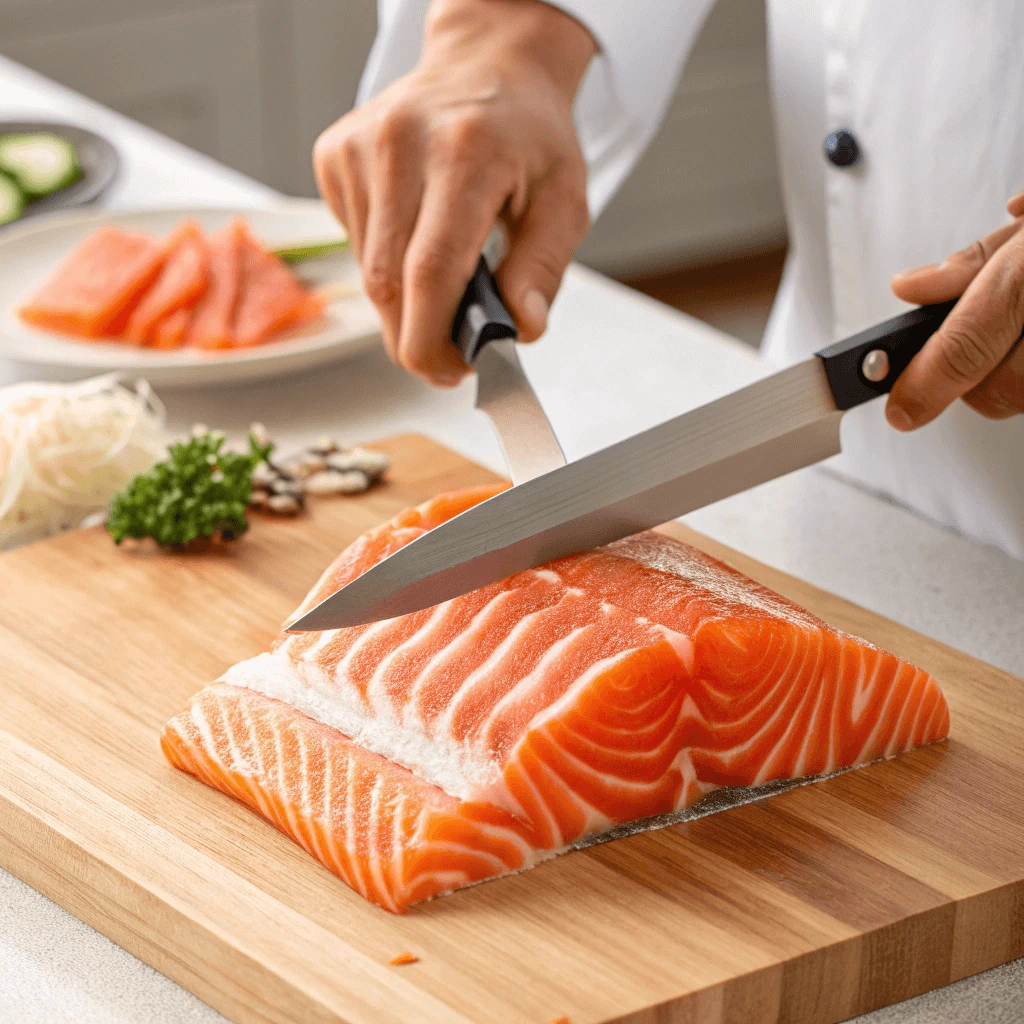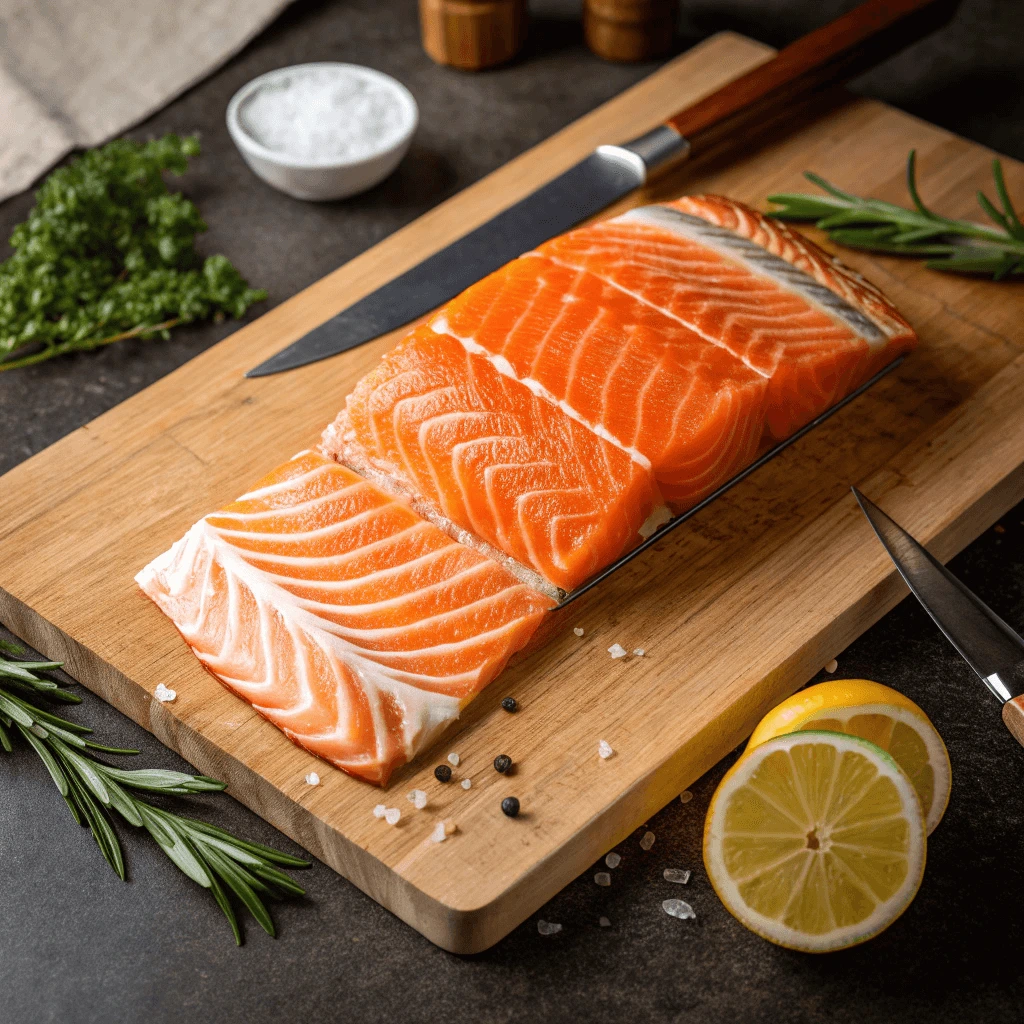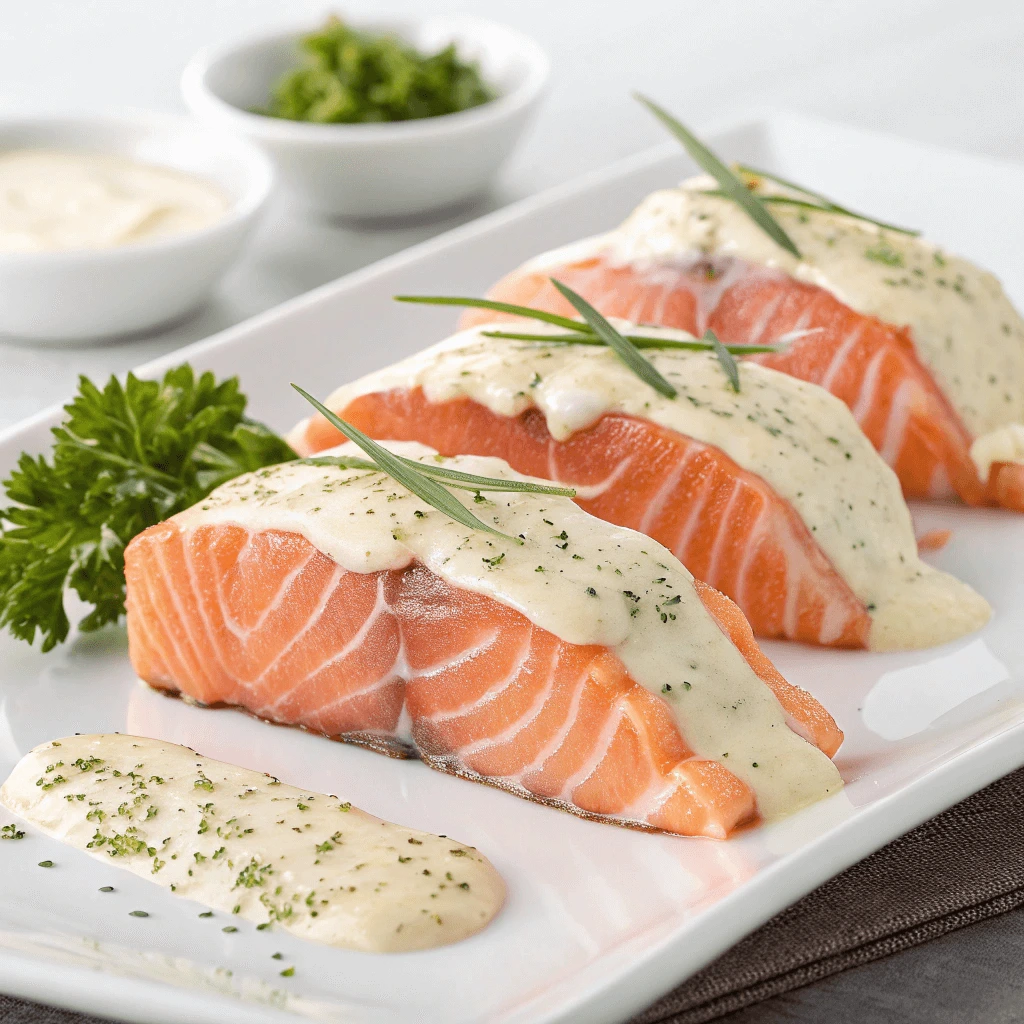Learning how to select and prepare sushi-grade salmon at home can elevate your sushi-making skills and allow you to enjoy restaurant-quality dishes in the comfort of your kitchen. Whether you’re a sushi enthusiast or a beginner, understanding how to choose the freshest salmon and prepare it properly is crucial to creating flavorful, safe, and delicious sushi. In this guide, we’ll walk you through the essential steps to select and prepare sushi-grade salmon at home, from choosing the right fish to mastering the slicing technique. By following these tips, you’ll be able to enjoy fresh sushi with confidence and impress your friends and family with your culinary skills.
What Is Sushi Grade Salmon at Home?

Definition and FDA Guidelines for Sushi Grade Salmon at Home
When it comes to making sushi at home, safety starts with understanding what “sushi grade” salmon really means. While the term sounds official, it’s important to know that “sushi grade” is not a regulated designation in the U.S. Instead, it’s a marketing term used by fishmongers and seafood suppliers to indicate that a fish is safe to eat raw—assuming it’s handled properly.
What Is “Sushi Grade” Salmon?
“Sushi grade” is a marketing term used by seafood sellers to indicate that the fish is safe to eat raw. It doesn’t come from any official government certification. Instead, it refers to fish that’s fresh, high-quality, and handled properly—especially when it comes to freezing for parasite control.
FDA Freezing Requirements for Raw Fish
The U.S. Food and Drug Administration (FDA) provides strict guidelines for freezing fish intended for raw consumption. These rules help kill parasites like Anisakis, which are common in wild salmon. According to the FDA, fish should be:
- Frozen at -4°F (-20°C) for 7 days, or
- Frozen at -31°F (-35°C) until solid, then stored for 15 hours at the same temperature, or
- Frozen at -31°F until solid, then held at -4°F for 24 hours
These freezing methods prevent parasite-related illness without affecting texture or flavor.
Why It Matters for Home Sushi
Home freezers usually can’t reach temperatures low enough to meet these standards. That’s why it’s safer to buy sushi grade salmon from a trusted source—such as a reputable fish market or seafood supplier. They use industrial freezing techniques that comply with FDA rules, giving you peace of mind when preparing raw salmon dishes at home.
Sushi Grade vs. Sashimi Grade
The labels “sushi grade” and “sashimi grade” often appear at seafood markets, but they can confuse home cooks. While they sound official, neither term is regulated by the FDA or any governing body. Let’s break down what they mean and how to choose the right one for your needs.
Understanding the Terms
“Sushi grade” and “sashimi grade” both imply that the fish is safe to eat raw. However, there’s a slight difference in how sellers and chefs use these terms:
- Sushi grade fish is typically intended for use in sushi, which often includes rice and additional ingredients.
- Sashimi grade fish is usually the highest quality cut, served on its own—raw and sliced, with nothing to mask the flavor.
While both are suitable for raw consumption, sashimi grade fish is often more delicate, fresher, and better in texture since it’s meant to be the star of the plate.
Quality and Texture Differences
Seafood labeled as sashimi grade often comes from the center cuts of the fish, offering a uniform texture and fat distribution. Sellers may reserve the best portions—those with the finest grain and smoothest bite—for sashimi. Sushi grade salmon, while still high-quality, may include slightly different parts of the fish, depending on availability.
If you’re planning to serve raw salmon in its purest form, go with sashimi grade. If you’re making rolls or nigiri, sushi grade is perfectly fine.
How to Choose Between Them
Choose based on how you plan to serve the salmon:
- For sashimi platters or minimalist dishes, pick sashimi grade salmon for optimal taste and mouthfeel.
- For sushi rolls or nigiri, sushi grade salmon works beautifully, especially when paired with rice, avocado, or sauces.
When in doubt, ask your fishmonger how the fish was handled and which grade is better suited for your recipe.
Wild-Caught vs. Farmed Salmon
Choosing between wild-caught and farmed salmon is essential when preparing sushi at home. Both options offer unique advantages, and knowing the differences can help you pick the safest and most flavorful fish.
Wild-Caught Salmon
Wild-caught salmon lives in oceans or rivers and feeds on a natural diet, giving it a leaner texture and deeper flavor. Many people love its rich taste and firmer bite. However, wild salmon has a higher risk of carrying parasites, which makes it unsafe to eat raw unless it’s been frozen according to FDA guidelines. Always check if it’s labeled as sushi grade and professionally frozen before using it for raw dishes.
Farmed Salmon
Farmed salmon grows in controlled environments, which lowers the chance of parasite exposure. It’s typically higher in fat, resulting in a softer, buttery texture that many sushi lovers enjoy. Since farmed salmon carries a lower risk of parasites, it’s often safer for raw consumption, especially when you buy it from a reputable supplier.
Which One Is Better for Sushi?
Go with wild-caught salmon if you want bold flavor and you can verify it’s been frozen properly. Choose farmed salmon if you want a smoother texture and a lower risk of parasites. No matter your choice, always confirm that the fish is labeled sushi grade for safe at-home preparation.
How to Choose the Best Salmon for Sushi

Where to Buy Sushi Grade Salmon
Finding a trustworthy source for sushi grade salmon is key to preparing safe and delicious sushi at home. Not all fish markets or grocery stores offer truly sushi-safe salmon, so it’s important to know what to look for and where to shop.
Specialty Fish Markets and Japanese Grocery Stores
Start your search at reputable fish markets or Asian grocery stores, especially those that specialize in Japanese cuisine. These places often stock seafood that’s specifically labeled as sushi or sashimi grade, and their staff can usually answer questions about how the fish was handled and frozen. If a store focuses on fresh seafood for raw dishes, it’s more likely to carry high-quality options.
Online Seafood Retailers
Several trusted online retailers now sell sushi grade salmon and ship it straight to your door. Companies like Catalina Offshore Products, Fulton Fish Market, or Sea to Table use proper freezing methods and packaging to keep the fish safe during delivery. Always check if the seller provides information about freezing standards and sourcing methods.
What to Look For When Buying
No matter where you shop, make sure the salmon:
- Is clearly labeled “sushi grade” or “sashimi grade”
- Comes from a seller that follows FDA freezing guidelines
- Looks vibrant, smells fresh (not fishy), and has a firm texture
Ask questions. A good seller will be transparent about sourcing and handling. If the store staff can’t confirm how the salmon was frozen, it’s best to choose a different source.
Visual and Smell Checks
Before using any salmon for sushi, you should always perform quick but essential quality checks at home. Appearance and smell can tell you a lot about freshness and safety.
Examine the Color and Texture
Start by checking the color. Sushi-grade salmon should appear vibrant and consistent, with shades of bright orange to deep coral. Avoid salmon that looks dull, grayish, or has brown edges—these are signs of age or poor handling.
Next, check the texture. Fresh, high-quality salmon should feel firm and slightly springy when touched. If it feels slimy, mushy, or sticky, do not use it for raw consumption. Quality sushi-grade fish holds its shape and doesn’t leave residue on your fingers.
Look for Signs of Dehydration or Damage
Inspect the surface closely. Properly stored salmon will have a slightly glossy sheen, not a dried-out or flaky appearance. You should also avoid fish that has cracks, deep discoloration, or uneven cuts, as these may indicate poor handling or exposure to air.
If you’re buying pre-cut pieces, make sure the packaging is clean and secure. Cloudy packaging, excess liquid, or broken seals suggest the fish may not be safe to eat raw.
Smell the Salmon Carefully
Finally, use your nose. Fresh salmon should smell clean and slightly oceanic, almost like seawater. If you detect a sour, overly fishy, or ammonia-like odor, discard it immediately. These smells indicate spoilage, even if the fish looks acceptable.
When in doubt, trust your senses. If the salmon looks off or smells strange, don’t take the risk—especially when eating it raw.
Questions to Ask Your Fishmonger
When buying sushi-grade salmon, asking the right questions can help ensure you’re getting the freshest, safest fish for raw consumption. Here are some important questions to ask your fishmonger:
1. Is This Salmon Sushi Grade?
Always confirm that the salmon is labeled sushi grade or sashimi grade. This ensures the fish meets the necessary freezing standards for raw consumption. If the fishmonger confirms it’s sushi grade, ask how the fish was handled to meet these requirements.
2. Was This Salmon Frozen?
To eliminate parasites, sushi-grade salmon must be frozen to specific temperatures. Ask if the fish was frozen at -4°F (-20°C) for at least seven days or -31°F (-35°C) for 15 hours. Proper freezing is essential for safety when consuming raw fish.
3. Where Does This Salmon Come From?
Inquire about the salmon’s origin—whether it’s wild-caught or farmed. Wild-caught salmon often has a firmer texture, while farmed salmon can be softer. Ethical sourcing also impacts the fish’s quality, so knowing where it comes from is important.
4. How Fresh Is This Salmon?
Freshness is critical when preparing raw dishes. Ask when the salmon arrived at the market and whether it has been stored on ice. The fresher the fish, the better it will taste and the safer it will be to eat raw.
5. Can I See the Whole Fish or Fillet?
If you’re purchasing pre-cut salmon, ask to see the whole fish or larger fillet to ensure you’re getting the best quality. Whole fish often have more consistent texture and better cuts for sushi.
Preparing Sushi Grade Salmon at Home

Tools You’ll Need
To prepare sushi-grade salmon at home, you’ll need a few key tools to ensure safe and precise handling. Here’s a list of the essentials:
1. Sharp Filleting Knife
A sharp filleting knife is crucial for clean, precise cuts. A sashimi knife or any high-quality, flexible blade will help you slice the fish without tearing it.
2. Cutting Board
A large, clean cutting board is necessary to work on the fish. Choose wooden or plastic boards, which are easy to clean and gentle on the fish.
3. Fish Tweezers
Fish tweezers help remove any small bones from the fillet. While optional, they provide precision for a smooth sushi experience.
4. Clean Cloth or Paper Towels
Use a clean cloth or paper towels to pat the fish dry before slicing. This ensures smooth cuts and prevents moisture from affecting the fish’s texture.
5. Storage Containers or Ice Packs
To maintain the salmon’s freshness, store it on ice or in airtight containers. Proper storage ensures that the fish stays fresh until you’re ready to use it
How to Slice Salmon for Sushi and Sashimi
Slicing salmon for sushi or sashimi requires careful technique to preserve its texture and flavor. Follow these steps for perfect slices:
1. Prepare the Salmon
Start with a chilled salmon fillet. Remove any skin or bones if necessary, but some prefer leaving the skin on for extra texture.
2. Use the Right Knife
A sharp filleting or sashimi knife is essential. A sharp knife ensures clean, smooth cuts, while a dull knife can tear the fish.
3. Slice Against the Grain
Always cut against the grain of the fish for tender, melt-in-your-mouth slices. Cutting with the grain makes the fish chewy.
4. Cut at an Angle
Slice the fish at a 45-degree angle for wider, more visually appealing pieces. This also enhances the texture, especially for sashimi.
5. Smooth Cutting Motion
Use a smooth, sliding motion when cutting. Let the weight of the knife guide the cut, avoiding any downward pressure that can tear the fish.
6. Arrange the Slices
After slicing, arrange the pieces on your plate. For sashimi, neatly overlap them, and for sushi, place the slices atop small rice mounds.
Safety and Hygiene Tips
When preparing sushi-grade salmon, maintaining proper hygiene is crucial for both quality and safety. Follow these essential tips to ensure the best results:
1. Clean Your Workspace
Clean all surfaces, cutting boards, and utensils with hot, soapy water before and after handling raw fish to prevent cross-contamination.
2. Wash Your Hands
Wash your hands thoroughly with soap and water for at least 20 seconds before and after touching the fish, as well as after handling kitchen tools.
3. Store Salmon Correctly
Store salmon at or below 40°F (4°C) in the coldest part of your refrigerator, and use it within 24 to 48 hours for best freshness. For longer storage, freeze it immediately after purchase.
4. Use Separate Tools
Designate separate knives and cutting boards for raw fish to avoid contamination. If you must reuse tools, sanitize them thoroughly.
5. Don’t Leave Fish at Room Temperature
Raw fish should never be left out for more than two hours at room temperature to prevent bacterial growth.
6. Check for Freshness
Inspect salmon for discoloration, sliminess, or a foul smell. If it looks or smells off, discard it to avoid foodborne illness.
7. Use Ice for Freshness
Keep the salmon cold by placing it on a plate or tray over ice while preparing. This helps maintain freshness and prevents bacterial growth.
8. Prevent Cross-Contamination
Clean all utensils and surfaces between handling raw fish and other ingredients to avoid cross-contamination. Use separate tools for raw fish and other foods.
Common Mistakes to Avoid When Using Raw Salmon
Not Freezing at the Correct Temperature
Freezing sushi-grade salmon properly is crucial for ensuring its safety and quality. If not frozen at the correct temperature, you risk compromising the fish’s safety and texture.
Why Freezing Matters
Freezing salmon at -4°F (-20°C) or lower for at least 7 days kills parasites like anisakis. This step is recommended by the FDA to ensure the fish is safe for raw consumption.
Risks of Incorrect Freezing
Freezing at an improper temperature may allow parasites to survive, posing a health risk. Additionally, fish frozen too slowly or at a higher temperature may become mushy once thawed, affecting its texture.
How to Freeze Properly
Ensure your freezer is set to -4°F (-20°C) or lower. Wrap the salmon tightly in plastic wrap or vacuum-sealed bags to prevent freezer burn. If possible, use a deep freezer for more consistent temperatures.
Thawing Safely
Thaw frozen salmon in the refrigerator for several hours or overnight. Avoid thawing at room temperature to prevent bacterial growth. For quicker thawing, submerge the sealed fish in cold water, but never use warm water.
Using Poor Quality or Non-Sushi Grade Fish
Choosing the right fish is essential when preparing sushi at home. Non-sushi-grade fish or low-quality fish can pose safety risks and compromise the quality of your sushi.
What Is Non-Sushi Grade Fish?
Non-sushi-grade fish has not been frozen to the required temperatures to kill parasites and bacteria. Without this step, consuming the fish raw can pose health risks.
Health Risks of Poor Quality Fish
Non-sushi-grade fish can harbor parasites like anisakis and harmful bacteria such as Salmonella. Eating raw fish that hasn’t been properly handled increases the risk of foodborne illnesses, which can cause severe stomach issues.
Impact on Flavor and Texture
Sushi-grade fish is carefully handled to preserve its freshness and delicate texture. Using poor-quality fish results in a less enjoyable sushi experience, with potential issues like a mushy texture or unpleasant flavor.
How to Identify Sushi-Grade Fish
Always buy fish labeled as sushi-grade or sashimi-grade. These have been frozen at the right temperatures and are safe for raw consumption. Ask your fishmonger if you’re uncertain.
Why Quality Matters
Using low-quality fish can lead to health risks, poor texture, and bad flavor. Sushi-grade fish ensures your sushi is both safe and delicious, offering a better overall experience.
Cross-Contamination in the Kitchen
Cross-contamination is a major concern when preparing sushi at home. It occurs when harmful bacteria or parasites spread from raw fish to other food items, surfaces, or utensils. Preventing cross-contamination ensures your sushi is safe to eat and reduces the risk of foodborne illnesses.
What Is Cross-Contamination?
Cross-contamination happens when harmful microorganisms from raw fish transfer to other surfaces or foods. This can happen through cutting boards, knives, or even your hands if not properly sanitized.
Why It’s Dangerous
When raw fish, such as sushi-grade salmon, comes into contact with other foods, bacteria like Salmonella or Listeria, or parasites like Anisakis, can spread. This increases the risk of foodborne illness. Proper hygiene helps eliminate this risk.
Common Areas of Cross-Contamination
- Cutting Boards and Knives: Use separate boards and utensils for raw fish and other food items. Clean and sanitize them after each use.
- Hands: Always wash your hands before and after handling raw fish. Consider wearing gloves for added protection.
- Work Surfaces: Disinfect countertops and surfaces that come into contact with raw fish.
How to Prevent Cross-Contamination
- Separate Tools and Surfaces: Use a dedicated cutting board and knife for raw fish. Avoid using them for other foods.
- Wash Hands Regularly: Wash your hands thoroughly with soap and water before and after touching raw fish.
- Sanitize Properly: Clean all surfaces and utensils after preparing raw fish with food-safe disinfectants.
- Store Fish Correctly: Keep raw fish in the refrigerator at 32°F (0°C) or freeze it to eliminate parasites.
By following these practices, you can ensure a safe and enjoyable sushi experience without worrying about contamination.
Delicious Ways to Enjoy Sushi Grade Salmon at Home
Simple Salmon Nigiri and Sashimi Using Sushi Grade Salmon at Home
Making Salmon Nigiri and Sashimi at home is simpler than you might think. Both dishes highlight the fresh, delicate flavors of sushi-grade salmon, and you only need a few basic ingredients.
Salmon Nigiri:
Nigiri consists of a small ball of seasoned sushi rice topped with a slice of raw fish. Here’s how to prepare it:
- Prepare Sushi Rice: Cook short-grain sushi rice and season it with rice vinegar, sugar, and salt. Let it cool to room temperature.
- Slice the Salmon: Use a sharp knife to slice sushi-grade salmon into thin pieces, about 1/4 inch thick.
- Assemble: Wet your hands and shape a small portion of rice into an oval. Top with a slice of salmon. Add a small dab of wasabi between the rice and fish if desired.
Salmon Sashimi:
Sashimi is simply thin slices of raw fish without rice. Here’s how to prepare it:
- Choose Sushi-Grade Salmon: Ensure the fish has been properly frozen for safety.
- Slice the Salmon: Cut the salmon against the grain into thin, uniform slices.
- Serve: Arrange the slices on a plate and garnish with daikon radish or herbs. Serve with soy sauce, wasabi, and pickled ginger.
Tips for Both Dishes:
- Freshness is Key: Always use sushi-grade fish for the best flavor.
- Use a Sharp Knife: A sharp knife ensures clean, smooth cuts.
- Serve Fresh: Both dishes are best enjoyed immediately after preparation.
Creative Sushi Rolls (Maki & Uramaki) Using Sushi Grade Salmon at Home
Salmon sushi rolls are a fun and easy way to enjoy sushi at home. The two most popular styles are Maki (traditional rolls) and Uramaki (inside-out rolls), both of which feature fresh sushi-grade salmon.
How to Make Salmon Maki Rolls:
- Prepare the Ingredients: Slice sushi-grade salmon, cucumber, and avocado into thin strips.
- Prepare the Sushi Rice: Cook sushi rice and season it with rice vinegar, sugar, and salt.
- Assemble the Roll: Spread a thin layer of rice on a sheet of nori, then place the salmon, cucumber, and avocado along the center.
- Roll and Slice: Use a bamboo mat to gently roll the sushi, then slice into bite-sized pieces.
How to Make Salmon Uramaki Rolls:
- Prepare the Ingredients: Slice the salmon, cucumber, and avocado.
- Assemble the Roll: Spread a layer of rice on nori, flip it, and place your fillings on the nori.
- Roll and Slice: Roll tightly, with the rice on the outside, then slice into pieces. Garnish with sesame seeds or roe.
Tips for Perfect Rolls:
- Sharp Knife: Use a sharp knife for clean cuts.
- Rice Texture: The rice should be sticky but not overly wet.
- Experiment with Fillings: Add ingredients like cream cheese, spicy mayo, or tempura veggies.
Serve your rolls immediately with soy sauce, wasabi, and pickled ginger on the side.
Making a Salmon Poke Bowl or Tartare with Sushi Grade Salmon at Home
Salmon poke bowls and tartare are delicious ways to enjoy sushi-grade salmon. Both dishes focus on fresh, raw fish but with different styles and flavor profiles.
Salmon Poke Bowl
A poke bowl features cubed, marinated salmon served over rice with various toppings. It’s a Hawaiian-inspired dish known for its vibrant, fresh ingredients.
- Prepare Ingredients: Dice salmon, cook rice, and prepare vegetables like avocado and cucumber.
- Marinate Salmon: Combine soy sauce, sesame oil, and lime juice. Marinate the salmon for 15–30 minutes.
- Assemble the Bowl: Place rice in a bowl, top with marinated salmon and veggies. Add sesame seeds, seaweed, or spicy mayo for extra flavor.
Salmon Tartare
Salmon tartare involves finely diced raw salmon mixed with seasonings, often served as an appetizer or light meal.
- Prepare Ingredients: Finely chop salmon, then add lemon juice, mustard, olive oil, and capers.
- Mix Ingredients: Gently combine everything without overworking the fish.
- Serve: Chill for a few minutes, then serve with crackers or toast.
Tips for Both Dishes:
- Freshness: Use the freshest sushi-grade salmon for the best taste and texture.
- Seasoning: Balance flavors carefully; don’t overpower the fish.
- Customization: Add fruits like mango or pineapple for a unique twist.
Conclusion
Enjoying sushi grade salmon at home is a rewarding experience when you know how to select, store, and prepare it correctly. By understanding the differences between sushi grade and sashimi grade, choosing the right sources, and following proper safety and hygiene practices, you can create delicious dishes like poke bowls, tartare, and sushi rolls. With the right tools and techniques, you can confidently enjoy sushi grade salmon at home and bring a taste of authentic sushi to your kitchen.
